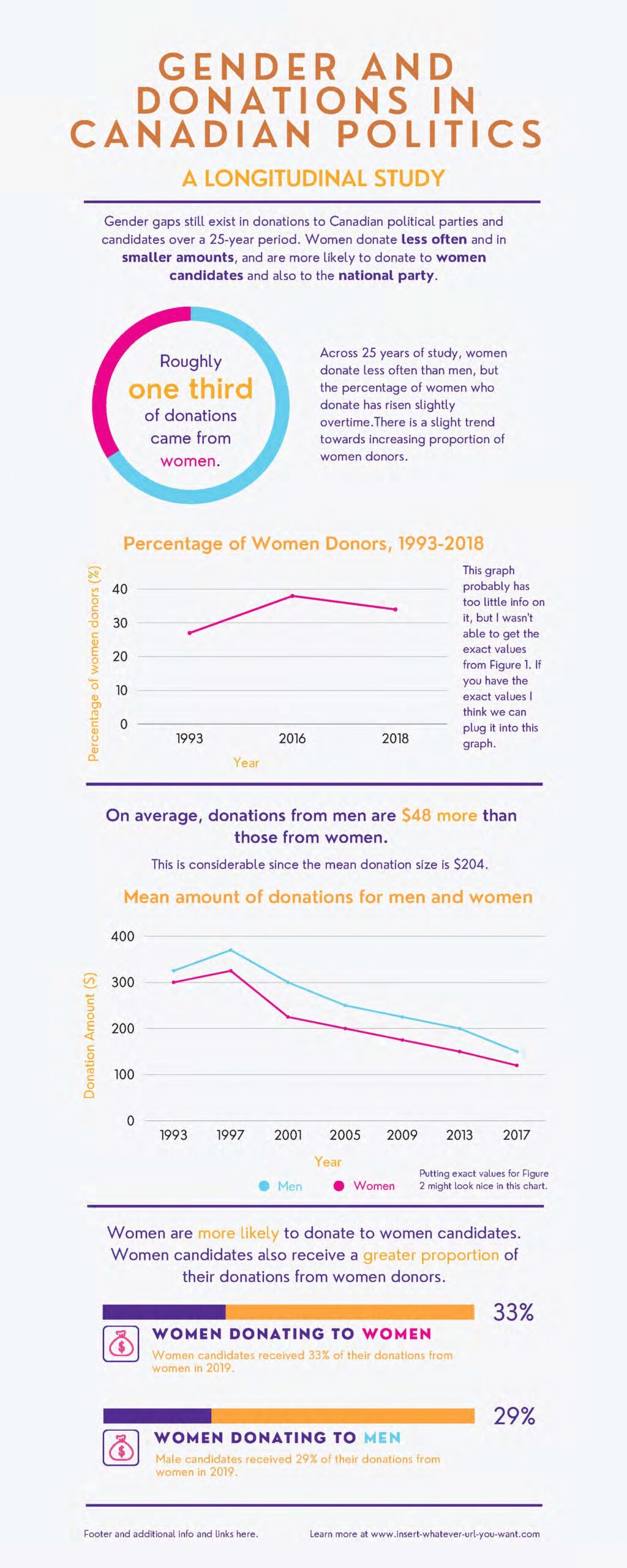Gender and donations in Canadian elections
Gender gaps in voter turnout and electoral representation have narrowed, but gaps in other forms of political participation remain.
In “Who Controls the Purse Strings: A Longitudinal Study of Gender and Donations in Canadian Politics,” Randy Besco, Semra Sevi and I examine gendered differences in donations. Donations are important because they furnish campaigns with necessary resources, provide voters with cues about candidate viability, and influence which issues politicians prioritize. This article has been accepted for publication in Politics & Gender.
We exploit an administrative dataset to analyze donations to Canadian parties and candidates over a 25-year period. We use machine learning to estimate donor gender and then link these data to candidate and party characteristics. Importantly, and in contrast to null effects from research on gender affinity voting, we find women are more likely to donate to women candidates, but women donate less often and in smaller amounts than men. The lack of formal gendered donor networks and the reliance on more informal, male-dominated local connections may influence women donors’ behavior. Change over a quarter-century has been modest, and large gender gaps persist.
Citation:
Tolley, Erin, Randy Besco and Semra Sevi (2020). Who Controls the Purse Strings? A Longitudinal Study of Gender and Donations in Canadian Politics. Politics & Gender 18(1): 244-272. doi:10.1017/S1743923X20000276.
The election of Valérie Plante
Although municipal politics is often viewed as more open to women, electoral under-representation persists, even at this level, and it is particularly acute in the mayor’s office. In Canada, just 18% of municipal mayors are women. In 2017, Valérie Plante broke the glass ceiling, becoming Montreal’s first woman mayor in the city’s 400-year history. Media coverage of her victory drew attention to her gender, but did gender matter all that much to voters?
In “Gender, Municipal Party Politics, and Montreal’s First Woman Mayor,” Mireille Paquet and I show how gender did and did not influence the outcome. A survey of Montreal electors reveals that gender was not a salient factor in their voice choice. However, as we argue, gender did shape the organization of the campaign and party. This article has been accepted for publication in the Canadian Journal of Urban Research.
We suggest that Plante’s victory can be explained in part by a strategy that showcased a less leader-centric party and a degendered campaign that helped counteract stereotypes about women’s unsuitability for positions of political leadership. Rather than positioning parties as a barrier to women’s political participation, as most past research does, we theorize them as a mobilizing institution with the potential to facilitate women’s electoral success at the local level. We heed the call for more research on local politics and, in doing so, our analysis highlights the evolution of municipal political parties from highly personalized, singularly focused electoral entities to more institutionalized and embedded features of local governance.
Citation
Tolley, Erin and Mireille Paquet (2021). Gender, Municipal Party Politics, and Montreal’s First Woman Mayor. Canadian Journal of Urban Research 30(1): 40-52. Article page
Photo credit: Guillaume Levasseur, Le Devoir
Ethnicity and political donations
Despite increased attention to ethnic differences in political behavior, there is little research on ethnic minorities as political donors and almost none outside the United States.
We draw on an administrative dataset of contributions to candidates, which we augment with donors’ ethnicity. Focusing on the 2015 Canadian election, we find ethnic minorities are generally less likely to donate than other Canadians, but South Asian Canadians donate at astonishingly high rates. Contrary to previous research, there are only modest differences in the size of donations across ethnic groups.
Linking donation data to candidate characteristics and census data reveals substantial co-ethnic affinity effects among Chinese and South Asian Canadians. Even in the absence of co-ethnic candidates, however, South Asians donate at a substantial rate. The proportion of donations to out-of-district and weaker candidates is also quite high, which could signal symbolic considerations are especially important to ethnic minority donors. The substantial heterogeneity between ethnic groups and the different effects on rates versus size of donations add important nuance to our knowledge of ethnicity and political behaviour.
Citation
Race and candidate recruitment
There is growing attention to the descriptive representation of racialized minorities in politics. However, because of a systematic lack of data on nomination contestants’ racial backgrounds, most research looks at outcomes on election day, thus ignoring the crucial stages that help to shape minority candidate emergence.
Using a unique data set on nomination contestants and local party presidents in a recent Canadian election, this study demonstrates that while district diversity is one determinant of minority candidate emergence, the presence of a racialized local party president is also substantively important. In other words, if you’re a prospective candidate, who you know matters. The findings show that racialized party gatekeepers play a key role in the emergence of minority candidates, and these networks matter most in the districts with lower levels of racial diversity. The findings further suggest the general pattern of left-center parties facilitating minority candidate emergence may not apply in the Canadian context.
Citation
Tolley, Erin. 2019. Who You Know: Local Party Presidents and Minority Candidate Emergence. Electoral Studies 58: 70-79. https://doi.org/10.1016/j.electstud.2019.02.007
Do women do better in municipal politics?
Conventional wisdom suggests that women might find greater electoral success in local politics than in politics at the federal and provincial level. Local politics is viewed as more part-time, less competitive, and closer to women’s perceived policy interests. But is this true? Do women do better in municipal politics?
Using a longitudinal data set that traces women’s presence in elected office in Canada, this study casts doubt on the notion of a municipal advantage. It finds instead that women are present in roughly equivalent proportions across all three levels of government and that their numerical presence has rarely exceeded 25 percent at any level of government. The article thus challenges a pervasive theme in the literature on women in politics.
Citation
Erin Tolley. 2011. Do Women “Do Better” in Municipal Politics? Electoral Representation across Three Levels of Government. Canadian Journal of Political Science 44(3): 573-594.





